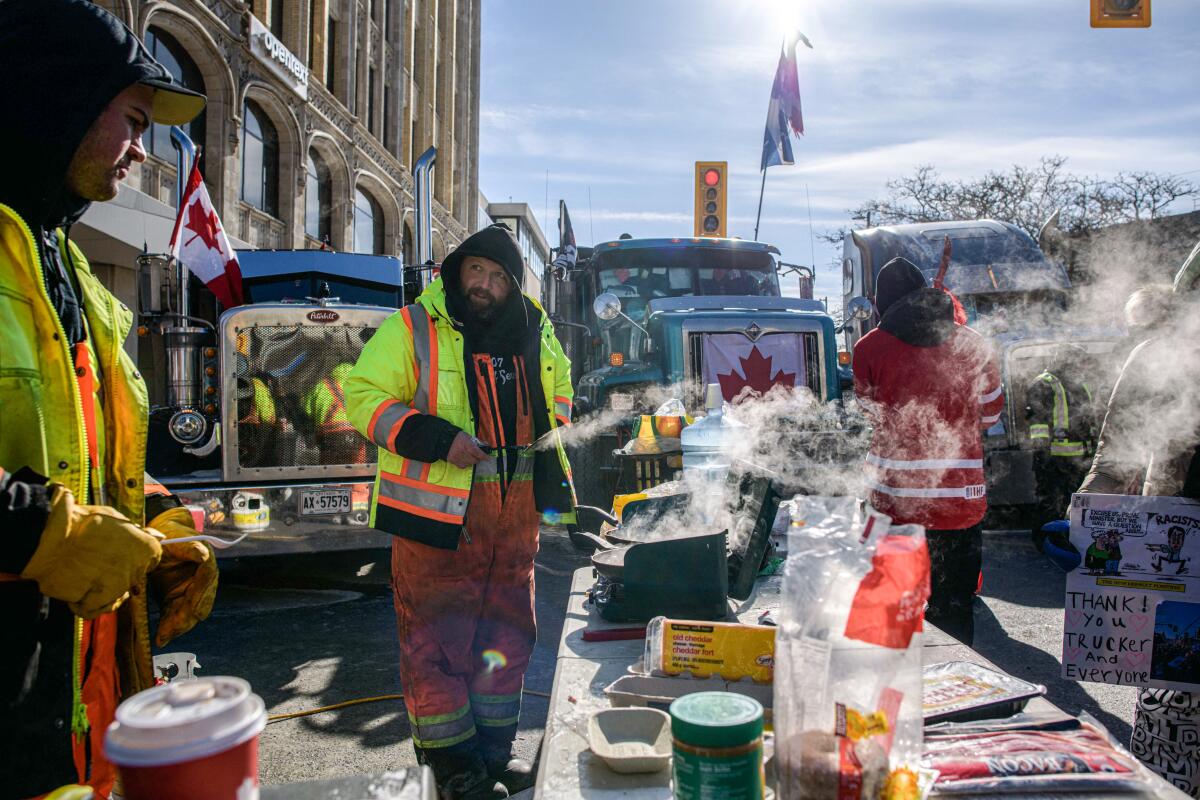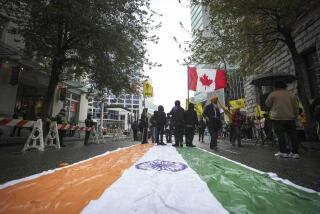Canada’s Trudeau moves to stop blockades by opponents of vaccine mandates, pandemic restrictions

- Share via
OTTAWA, Canada — Seated in an 18-wheeler, Tyler Armstrong vowed Monday that he would not vacate his coveted parking space in front of Canada’s Parliament building until COVID-19 vaccination mandates and other pandemic restrictions were lifted.
His big rig is among scores of trucks and other vehicles that have been parked on Ottawa’s so-called Parliament Hill for more than two weeks as part of a protest against government measures meant to contain COVID-19.
“We’ll stay here as long as we have to,” said Armstrong, 25, as his girlfriend, Ashley Wapshaw, 26, nodded in agreement. “This is about freedom.”
The self-styled “Freedom Convoy” has largely paralyzed the Canadian capital and — along with allied blockades on Canadian border crossings to the United States — become a worldwide symbol of the backlash against pandemic constraints. Critics say the demonstrations disrupt commerce, ignore science and intimidate opponents.
On Monday, Canadian Prime Minister Justin Trudeau, under intense pressure to do something about the mounting crisis, invoked emergency powers in a bid to help dismantle the blockades. Among other steps, the federal Emergencies Act — invoked for the first time since its passage in 1988 — could bolster police ranks and powers, compel towing firms to cooperate in removing vehicles, and facilitate the cancellation of licenses and insurance linked to trucks deployed in blockades.
“We cannot and will not allow illegal and dangerous activities to continue,” Trudeau told reporters. “These blockades are illegal and the time to go home is now.”
The seeming ultimatum raises the stakes to new heights in what has become an increasingly tense standoff between the boisterous protest movement and the Trudeau government. Canada requires that unvaccinated Canadian truckers quarantine upon returning to Canada, and provinces across the country have varying rules in place mandating mask-wearing and showing proof of vaccination before entering restaurants and other venues.
A blockade of the Ambassador Bridge connecting Detroit and the Ontario city of Windsor was finally broken and traffic began flowing anew on the crucial commercial artery late Sunday after police moved in, arresting some demonstrators and towing away vehicles. President Biden had spoken to Trudeau two days earlier about the importance of reopening the Ambassador Bridge, a key span for auto manufacturers in both nations.
But Canada faces a much more daunting challenge in Ottawa, where hundreds of vehicles — many of them big rigs — anchor protests that sometimes include thousands of participants, dwarfing the gatherings along the border in Windsor, some 500 miles to the southwest.
The well-organized rallies in the capital feature stands offering free food and water, a stage where supporters extol the cause of “freedom” and regularly denounce Trudeau’s Liberal government, and high-powered speakers blaring out rock and other music.
The capital protesters have vowed repeatedly not to leave until vaccine mandates, mask-wearing requirements and other rules are lifted permanently. Trudeau’s tough talk did not seem to faze them.
“We’re not going anywhere until the mandates are gone and protections are in place so this kind of violation does not happen again,” said Benita Pedersen, 43, a protest organizer. “People have suffered for too long.”
The demonstrators say they do not object to those who want to be vaccinated, wear masks or take other protective measures. But they assert that being forced to take such steps is coercive.
“It should be up to the individual what they do, whether they get vaccinated or not,” said Brooke West, 31, an office administrator who was among several hundred demonstrators gathered Monday outside Canada’s ornate Parliament building. “That’s our choice.”
The protests have tapped into a worldwide fatigue with the restrictions meant to tame COVID-19.
“Of course, people are tired, frustrated, sick of the pandemic,” Trudeau said Monday. “They want it to be over.”
However, polls show that Canadians have generally supported restrictions meant to control COVID-19. About 85% of Canadians are fully vaccinated — compared with 65% in the United States, according to Johns Hopkins data — and Canada has about one-third the death rate of the United States from coronavirus.
While truckers have led the Canadian protests, participants have come to include people from a wide range of occupations and viewpoints. They have converged on Ottawa from throughout Canada, and include some U.S. citizens. Political views of the demonstrators seem to span the spectrum from far right to far left, with many in between. Others say they are apolitical except on the issue of “freedom.”
“You really can’t say it’s one political viewpoint,” said David Paisley, 32, an organizer who spoke to a reporter in the Shack, a kind of control center built of plywood mounted atop a flatbed truck parked on Wellington Street, the main thoroughfare outside Parliament.
He and others say the convoy survives largely on donations and participants’ funds and deny allegations that it is bank-rolled via right-wing groups in the United States. Conservatives such as former President Trump and Texas Sen. Ted Cruz have lauded the movement.
One aspect of new emergency authority would allow banks to freeze funds suspected of aiding the protests, an effort to thwart crowd-source financing. GoFundMe said it suspended forwarding money raised for the Canadian truckers because of police reports of violence.
Despite single-digit temperatures, many participants sleep in their trucks or in tents. Others stay at hotels or with friends or family.
People run jerry cans of diesel and gasoline to keep vehicles running. Participants seem to cooperate with police, who have made no concerted effort to evict them.
The overall mood is upbeat, something like an extended block party. Demonstrators dance to the music and tote signs with messages such as “Facts Over Fear,” “No Vax Passports” and “End the Mandates.”
But officials in the capital characterize the protests as a nightmare siege of the normally low-key city along the Ottawa River. Many downtown businesses have closed and the city feels quasi-deserted, except for the demonstrators wandering about on ice-and-snow-covered streets waving Canadian flags and protest placards.
Residents have complained about harassment and noise. Frequent horn-honking has continued despite an Ontario Superior Court judge’s issuing of an injunction to stop the practice.
The provincial government of Ontario has declared a state of emergency imposing new fines of up to $100,000 for blocking roads and sidewalks. Residents of neighborhoods near the Parliament have suffered, says Ottawa Mayor Jim Watson.
“Those people need some kind of relief and reprieve from the horn-honking, the diesel spewing all night, catcalls and inappropriate behavior,” Watson told Canada’s CTV news.
The mayor has said he has requested 1,800 additional officers from federal and provincial authorities because the Ottawa police force is overwhelmed.
Canadian authorities have also seen evidence of “intimidation, harassment and expressions of hate” among the protesters, Marco Mendicino, Canada’s minister of public safety, told reporters Monday.
Protest organizers call such allegations attempts to demonize a grass-roots movement that threatens a well-entrenched status quo.
“This is really about love,” Pedersen, one of the organizers, told a raucous crowd mid-day Monday from the stage in front of Parliament. “It’s cold out there. Reach out and cuddle someone.”
More to Read
Sign up for Essential California
The most important California stories and recommendations in your inbox every morning.
You may occasionally receive promotional content from the Los Angeles Times.










